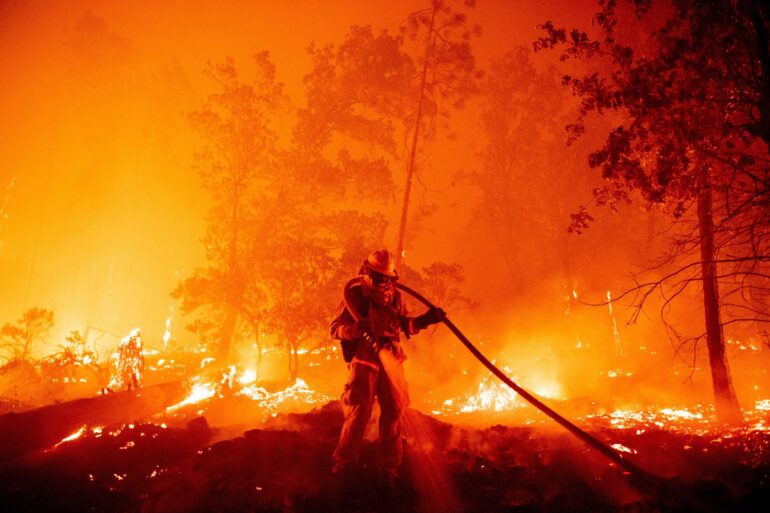TL;DR:
- Cal Fire employs AI models and a camera network to detect wildfires.
- AI recognizes visual signs of smoke, alerting firefighters swiftly.
- Response times are enhanced, enabling timely containment.
- AI detects 77 wildfires before 911 calls in pilot phase.
- Human validation is necessary for AI’s accuracy.
- Engineers vet AI’s fire alerts manually due to challenges.
- AI covers vast fire-prone areas, enhancing coverage.
- Collaboration with military’s Fireguard initiative and 911 calls reinforce detection.
- Skepticism remains about AI’s contextual understanding.
- Cal Fire AI program reduces wildfire damage in less destructive years.
Main AI News:
The cutting-edge landscape of technology continues to reshape various sectors, and California’s firefighting agency, Cal Fire, stands at the forefront of this transformation. With an unyielding commitment to safeguarding lives and landscapes from the menace of wildfires, Cal Fire is embracing the prowess of artificial intelligence (AI) to bolster its wildfire detection capabilities.
In a groundbreaking initiative highlighted by The New York Times and the Los Angeles Times, Cal Fire has orchestrated a formidable network comprising 1,039 high-definition cameras, strategically positioned to create an intricate web of vigilance across the state. These AI-equipped cameras have been meticulously trained to discern the telltale visual cues of wildfires. The result? A vigilant electronic sentinel, poised to swiftly detect the faintest wisp of smoke and promptly alert the firefighting forces.
Traditional methods of wildfire detection relied on the vigilant gaze of human operators monitoring a network of over 1,000 mountaintop cameras. However, the arduous nature of this task, combined with its inherent limitations, compelled Cal Fire to explore a more efficient alternative. Enter AI-powered solutions. Spearheaded by Phillip SeLegue, the astute staff chief of intelligence for Cal Fire, this innovation has redefined not only response times but also the preemptive identification of burgeoning blazes. By promptly identifying fires while they are still manageable in size, the AI system has proven its mettle.
Yet, as with any innovation, there are constraints to be acknowledged. The AI system’s efficacy is confined to fires that reside within the purview of its vigilant camera network. Human validation remains indispensable to affirm the accuracy of the AI model’s alerts. DigitalPath, the visionary California-based enterprise behind the AI software, has marshaled its engineering expertise to meticulously scrutinize each fire singled out by the AI. Ethan Higgins, the distinguished chief architect of the software, attests to the intricate challenges posed by phenomena such as fog, haze, and even the seemingly innocuous emissions from agricultural machinery and geothermal plants—elements that can often mimic the appearance of smoke.
Andrew Emerick, an experienced fire operator and duty chief for Cal Fire’s northern region, offers a pragmatic perspective on the AI’s role. While acknowledging its potential, he underscores the nuanced contextual comprehension required in understanding the origins of certain fires, especially those deliberately ignited for agricultural purposes. The human touch, he asserts, remains irreplaceable in these scenarios.
The AI juggernaut, powered by its capacity to process “billions of megapixels” of imagery every minute, stands as a sentinel over nearly 90 percent of California’s fire-prone expanse. The program’s inception in June marked a pivotal milestone, initially deployed across six of Cal Fire’s command centers. As September dawns, its dominion will expand to encompass all 21 command centers—a testament to the unyielding commitment to technological progress.
While AI stands as a formidable ally, Cal Fire employs an arsenal of complementary methodologies. Collaborations with residents via 911 calls and a strategic alliance with the United States military’s Fireguard initiative, leveraging classified spy satellites, drones, and aviation assets, reinforce their comprehensive approach. Neal Driscoll, a luminary steering the Cal Fire AI project, emphasizes that the program’s triumph resides in its ability to thwart fires that never make headlines—fires promptly quelled in their infancy.
The present year has witnessed a moderation in wildfire havoc compared to preceding seasons. Cal Fire’s data indicates 4,792 reported wildfires, a figure below the five-year average of 5,422 for the summer months. However, this statistical solace cannot attenuate the devastation of any wildfire spiraling beyond control.
Conclusion:
California’s strategic integration of AI-driven wildfire detection marks a pioneering leap in safeguarding against wildfires. The fusion of cutting-edge technology with human expertise fortifies the state’s ability to mitigate and prevent devastating fire outbreaks, presenting burgeoning market opportunities in AI-powered disaster response systems.

